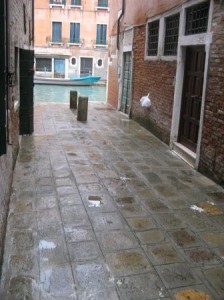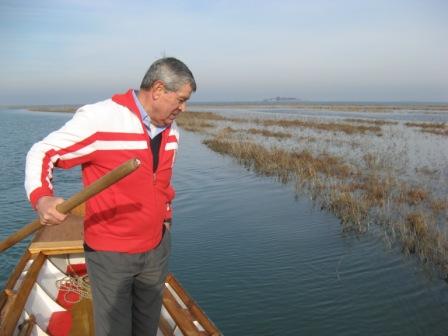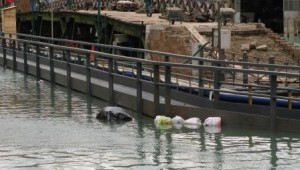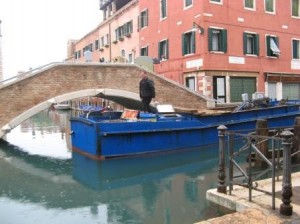I realize it may sound strange to refer to there being “plusses” to acqua alta. Let me just say I don’t mean “plusses” in the sense of winning a large chunk of the lottery. But there are in fact some positive aspects to it.

For instance, many Venetians have told me that acqua alta is a good thing because it washes the streets. This is true. Unfortunately, it also deposits a fine layer of silty slime. And while it does remove some of the dog poop, it also leaves detritus behind, so the general landscape isn’t much prettier than it was before the water rose. So, you know. We could go on like this, pro and con, all day.
But let me point out something that is hardly ever remarked on, in the many and varying accounts of this event: Acqua alta is actually a very good thing for the barene (the lagoon’s marshy wetland islets). If we can focus our minds briefly on something other than our own immediate convenience, it’s worth remembering that the lagoon has its own needs which are being met ever more rarely. So if it likes a good soak, I don’t see why it (by which I mean the whole ecosystem: microorganisms, plants, birds, etc.) can’t have it. Also — speaking selfishly — rowing when the water is high is magic.

Back in town, here are a few of the positive and less positive aspects of acqua alta, as I see them:
- It doesn’t last long. Acqua alta is a tidal event. Unlike your raging rivers, it has a predictable time frame. The tide comes in for six hours, and goes out for six hours. True, sometimes it doesn’t go out as much as it should, but it eventually does go out. This coming and going means that it’s really bothersome for only about two hours.
- It’s fairly tranquil. Inexorable, I grant you. Anyone who hasn’t watched the water rising near one’s front door (as we have) hasn’t fully grasped the fundamental meaning of “Time and tide wait for no man.” But the typical reports of high water in Venice make it sound as if Niagara Falls is pouring through your living-room window (CNN once referred to the “Adriatic bursting its banks.” Banks? Bursting? Are we suddenly in Holland?), when in reality it’s more like the bathtub slowly overflowing. Water in both cases, I agree, but not really the same.
- It is predictable. True, raging rivers are also predictable, but some of the factors influencing acqua alta, such as the direction of the wind, can change. In addition, we get plenty of warning. If you don’t want to wait for the sirens to blare, just look at the barometer. (You do have a barometer, don’t you?) The lower the pressure, the higher the water. Check the sky: Full or new moon? There will be more pronounced highs and lows. Wind from the southeast? Not good; it will prevent (or slow) the regular retreat of the tide. We want a southwest wind (garbin) or better yet, northeast (bora). Those will settle acqua alta’s hash.
I’ll tell you what’s really annoying about acqua alta, apart from the distraught articles that keep getting published. It’s not that you have to put on boots for a few hours. It’s that:
- When the tide goes out, it leaves all kinds of detritus
This is a modest example of a street not long after the tide has gone out. Clumps of eelgrass and bits of reeds are unavoidable and even not so ugly. It's the other stuff, pieces of plastic and styrofoam and general junk littering every wet street that are ugly. Unavoidable, fine. But there is no telling when, if ever, someone is going to sweep it up. all over the sidewalks. Stuff that was just floating gently comes to rest on whatever pavement was just below it when the last inch retreated. Also, if anyone puts out a plastic bag of garbage the night before (yes, despite the warning sirens — dumb, I agree), that bag will be floating around the street and either settle on the pavement somewhere or drift out to sea. Neither case is highly desirable, though obviously the second is worse.

- The garbage-people will be extremely slow in collecting the trash and/or — make that just “or,” they can’t seem to do both in the same day, even when the sun is shining — sweeping away the detritus, which means the streets look more or less like a slum. The garbage-people are slow because … I’ve tried to understand this… It may be because they are already so desperately overworked that high water adds an insuperable burden (you’re believing this, yes?), and because they are otherwise urgently and industriously occupied in setting up or taking down the temporary walkways over the high water (sometimes yes, mostly no). But they seem to get a special pass on their normal work when the acqua is even moderately alta. I can’t explain it, except to compare it to the mysterious sore throat which a kid who doesn’t want to go to school suddenly develops when it rains or snows.
- Transport gets all scrambled up,
not only for taxis and barges but also some vaporettos and/or motoscafos. They have to change their normal routes because the high water prevents them from passing under certain bridges. There are alternatives by which they resolve this temporary dilemma, but it adds inconvenience to your own trajectory. As for heavy work boats and taxis, they either have to pick another route from A to B, or wait for the tide to turn. Tiresome, true, but hardly the stuff of calamity.
- Your front door swells. If you have been so unfortunate as to have even an inch of water come inside (and for many people, this just means it has reached the edge of a staircase leading up to their apartment, not the apartment itself), and your front door is made of wood, it will soak up the water and then want to stick. It will take a while to dry out. Like, maybe weeks. You may end up having to sand it down some. Irritating. Not disastrous.

I think if you’re going to live here you need to accept the fact that you’re sitting in the middle of a tidal lagoon. If that creates really too many problems, it might be good for you to consider moving. At least to the second floor, or maybe across the bridge to the mainland. No more worries about the tide coming ashore over there. All you have to deal with there, even as nearby as Mestre, are rivers and rain and totally inadequate storm drains. Which leads to flooded basements full of water that actually has little or no natural urge to recede. Fun.
No emotional articles about that, though. Who cares about a foot of water in somebody’s garage? Nobody — at least not until that somebody snaps a picture of a person rowing around the car or trailer.


 not only for taxis and barges but also some vaporettos and/or motoscafos. They have to change their normal routes because the high water prevents them from passing under certain bridges. There are alternatives by which they resolve this temporary dilemma, but it adds inconvenience to your own trajectory. As for heavy work boats and taxis, they either have to pick another route from A to B, or wait for the tide to turn. Tiresome, true, but hardly the stuff of calamity.
not only for taxis and barges but also some vaporettos and/or motoscafos. They have to change their normal routes because the high water prevents them from passing under certain bridges. There are alternatives by which they resolve this temporary dilemma, but it adds inconvenience to your own trajectory. As for heavy work boats and taxis, they either have to pick another route from A to B, or wait for the tide to turn. Tiresome, true, but hardly the stuff of calamity.
2 Comments
As I’m very interested in biology and ecology, I’d love to know more about how and why is the acqua alta good for the barene? Where do you have this information from?
Doesn’t the high water contribute to their erosion, even if the moto ondoso is a much greater factor?
A very quick internet search didn’t give me any useful information.
(The only info I found is that the barene help to soften the effects of high tides, acting as “natural sponges”, and thus the disappering of the barene makes the acqua alta worse. But this is a different topic.)
Briefly,the high water cleans and also brings nutrients to the barene. The barene accumulate stuff, like surfaces anywhere, and the high water floats away dead plant (or animal) matter, as well as the plastic, metal, and other trash which finds it way onto the barene either accidentally or is thrown away there by anonymous people who evidently consider the barene a one-size-fits-all garbage dump.
The salt in the water is important to various halophytic barene plants which are dependent on the salt in order to thrive. The mud particles which are deposited and/or carried away also bring an important load of nutrients. And with high water, the organisms living in the middle of the barene (not merely those along the edges),are able to benefit as well.
High water not only doesn’t damage the barene, I would say that it can’t damage them; if it were damaging, the barene would already have disappeared (or been shrunk) long ago. High water isn’t a recent phenomenon here, yet photographs as recent as 1950 show the lagoon as being full of sandbanks, barene, and other land forms at various depths or heights which have been utterly scoured away by the damage caused by motondoso.
Ongoing and expensive projects to reconstruct barene are futile because the channels now are so deep and the patterns of tidal flow have been so deranged (due first to the digging of the Canale dei Petroli, and now due to MOSE, as well as the ever-increasing motorized traffic) that barene which have been eroded away will inevitably continue to be eroded, and faster than before.
My sources are several professors of marine biology here, as well as older Venetians who have spent much of their lives in the lagoon and know it intimately.